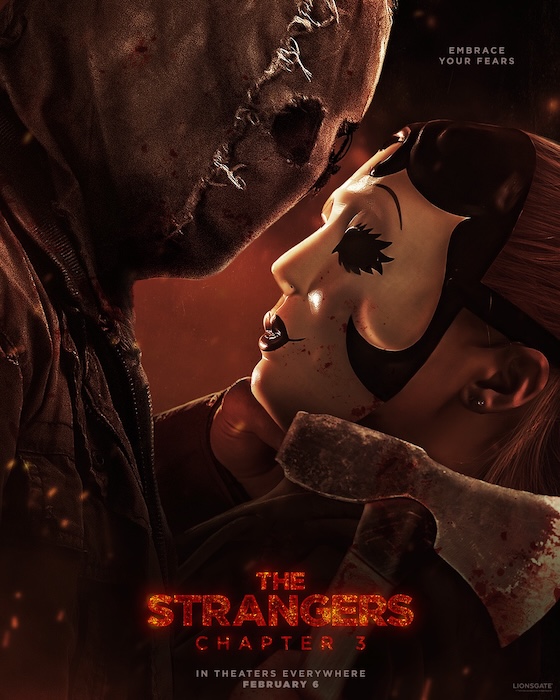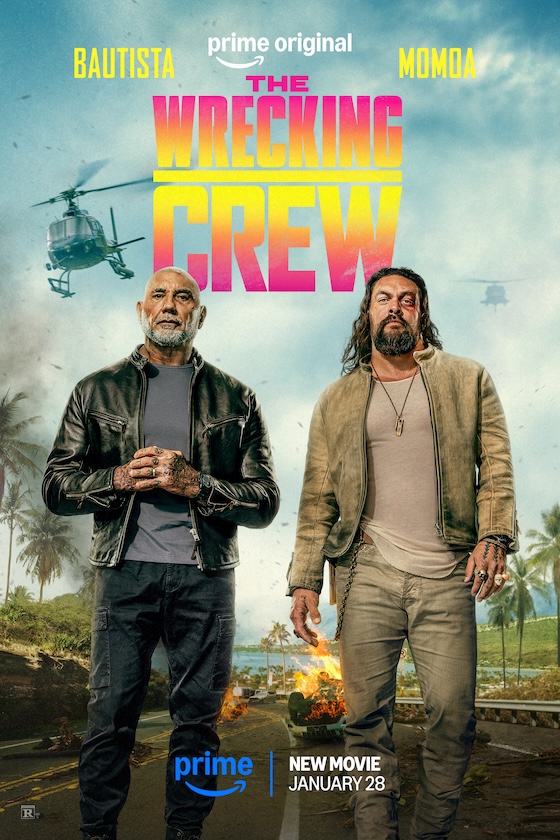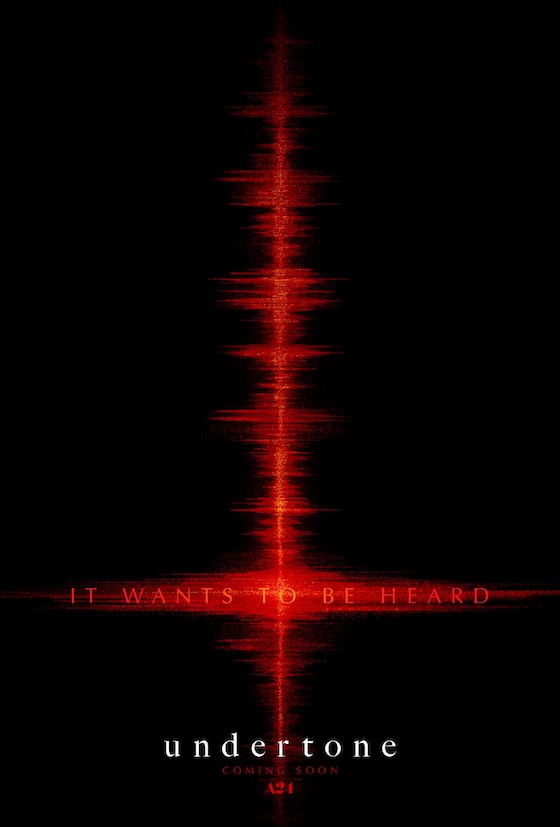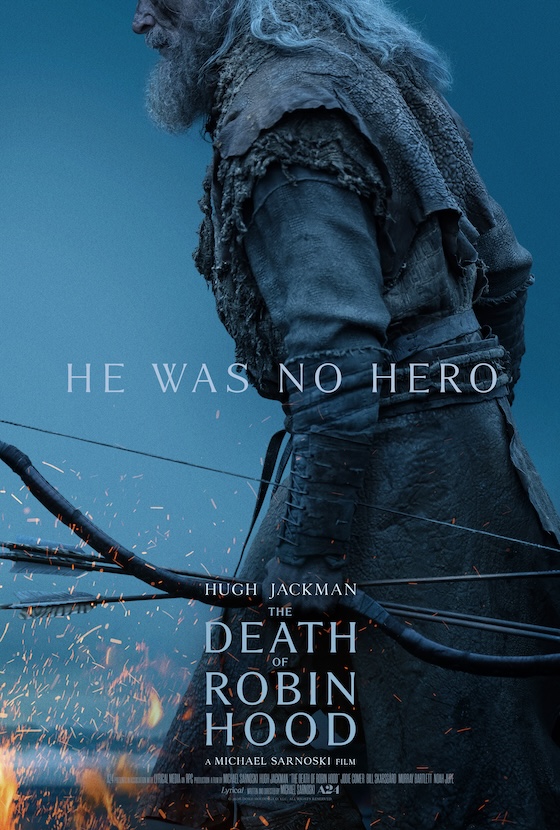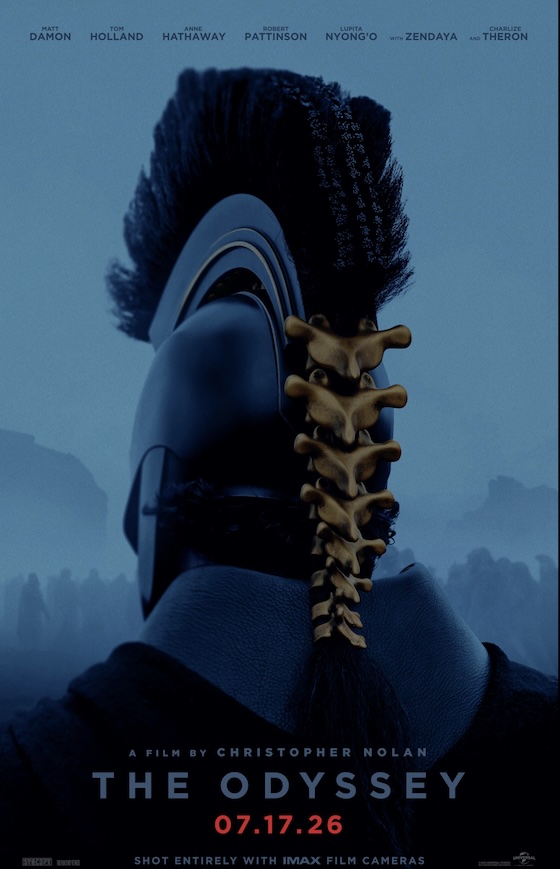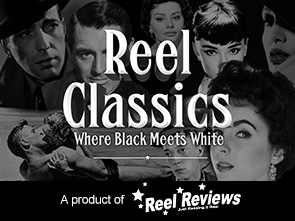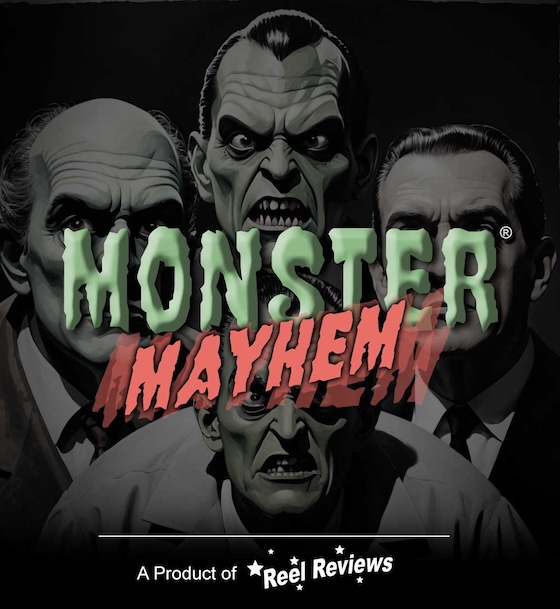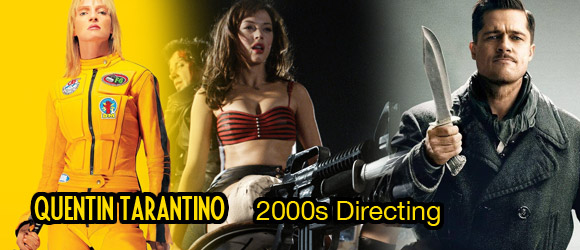
If one needed to sum up who Quentin Tarantino was in one word, I think the best one would be “pioneer.” He ushered in a new wave of film that is replicated over and over again, ad nauseum, until the entire pool is over saturated with Tarantino wannabees. He’s been nominated for his writing and his directing, and landed some of the once thought pastured actors Oscar nominations.
As we close out 2012, his most recent feature drops on Christmas Day - Django Unchained - we here at Reel Reviews decided it was best to reflect on the career of Quentin Tarantino. Tarantino represents a fantasy that every young writer would love to live out. He dropped out of high school to focus on his writing and sold multiple scripts and now he’s considered one of the most iconic directors of his generation, despite having directed less than 10 full features. When compared to Spielberg and Scorsese, he’s the youngling, but his collection of films have had just as much of an impact on the industry as both of those legendary directors. It’s a bold statement, but considering his catalog, his influence, I think it’s appropriate.
We’re breaking his career down into three sections: 1.) Writing (films he’s only written) 2.) 90s directing and 3.) 2000’s directing. All leading up to the debut of Django Unchained on December 25th. So if you’ve never heard of Quentin Tarantino, get ready to be... INFORMED!
For seven years there was no Tarantino. He’d made a name for himself after Pulp Fiction, and displayed some consistency on a small level with Jackie Brown. His next film was set to be Inglourious Basterds a remake (of sorts) of the war film from 1978 The Inglorious Bastards. The process for writing Basterds became larger in scope than the writer had originally thought. His plan to was to make a grand war film, but he wasn’t able to just yet.
There were several films at the time about World War II, so another one, one with comedy added to it, would not go over as well either. So he shelved it, which was a great idea given the eventual film. He shelved it in favor of a revenge plotted, 2 part, blood bath known as Kill Bill Vol. 1 & 2. Written as a whole film but filmed in two separate instances, Kill Bill is return for form for the director. It’s at this point that the purpose of Tarantino, the drive of him, is now fully realized.
The man’s not from our time, he’s from a time forgotten - when audiences were thrilled with what they were seeing, and not exposed to such intense sex and special effects. True, his films have excessive violence but that’s entertainment and not all of it as graphic as one would seem. For instance, Kill Bill is probably his goriest affair, but it’s to an absurd level that’s comical more than anything else.
Kill Bill: The Whole Bloody Affair
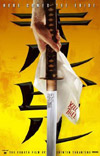
![]()
Uma Thurman reunites with Tarantino for Kill Bill, their last film was Pulp Fiction ten years prior. The goal of Kill Bill was to pay homage to Japanese martial arts film, and it’s done so wonderfully here. Utilizing masterful filmmaking techniques, Tarantino crafts the ultimate and very rewarding revenge flick. The films should count as a whole, and thus will be reviewed as a whole. Those who say things like “Vol II is better than Vol. I” are idiots. It’s one film - divided into two parts. Released in 2003 and 2004 with about 7 months between them, Kill Bill tells the story of The Bride, a former assassin who decides to leave her clan when she finds out she’s pregnant. Thurman is great in the role, she’s far less bubbly than she has been in the past, and everyone had probably forgotten about her up to this point.
She’s always been a skinny woman, but the flexibility and agility that Thurman displays in both volumes is incredible. She’s in top physical shape and shows it off very well. Her endearing nature is a great backdrop to her vicious intent. Thurman is The Bride, and you never doubt her for a second.
There are firings, and then there are FIRINGS. When you leave your job after doing something harsh to the employer, it usually relates to a bad reference. Not for Bill. David Carradine plays Bill, and his dismissal of the Bride is brutal. Accompanied by the rest of the Deadly Viper Assassination Squad, he enters the church where the Bride is set to marry and massacres everyone - her new fiance, all of his family, the priest, even the piano man. The squad takes turns beating the hell out of her, before Bill places one bullet in her head to finish the job.
Too bad for him, it doesn’t work, and she survives albeit in a coma. For years she sleeps before suddenly waking up. Her baby gone, a metal plate in her head, and feeling completely betrayed, The Bride (also known as Beatrix Kiddo) sets her sights on full blown revenge on every single member of the squad - Vivica A. Fox as Vernita Green (aka Copperhead), O-Ren Ishi played by Lucy Liu (aka Cottonmouth), Elle Driver played by Daryl Hannah (aka California Mountain Snake), and Bill’s brother - Bud, played by Tarantino favorite Michael Madsen (aka Sidewinder). The plot is to destroy each one, leading up to Bill - hence the title.
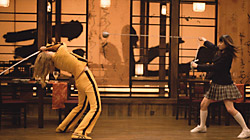 |
| Uma Thurman in Kill Bill |
The scope of Kill Bill is not just in how convoluted the plot is, but how much care is actually given to develop the Bride. This is Uma Thurman at her very best, and Tarantino wrote the script specifically with her in mind. There’s no doubt there were several stunt doubles and actual martial artists, but for consistency purposes, Thurman transforms from the girlish, ditsy slut from The Truth About Cats & Dogs to this unstoppable killing machine. It’s effective, but most importantly, it’s fun. A popular entry in the Tarantino filmography simply because of it’s high entertainment value, Kill Bill is an homage still and focuses on several types of filmmaking to tell the story. It incorporates spaghetti western styles, Japanese yakuza film, martial arts, animation, blaxploitation, among others.
One can’t speak of Kill Bill and not touch on The Brides battle with the Crazy 88s. This scene takes the Bride to Tokyo where she decimates the 88 bodyguards protecting O-Ren. It’s the bloodiest scene in the entire film (both volumes) and it’s a high point of film for the 2000s because of the seamless production and camera work by Tarantino. A lot of time went into making this one of the most graphic fight scenes to pay homage to those yakuza films from Japan, and each death is marked with a type of uniqueness that you won’t find in a lot of film these days. It may seem preposterous to refer to a death scene as art, but that’s essentially what we have going on here with Kill Bill.
The volumes are decidedly different. Vol. 1 focuses on the first part of revenge, the very basic, graphic, even sadistic violence that befalls Beatrix’s foes. Vol II is the least favorite of audiences, but the more critically lauded since it spends more time devolving Beatrix and her occupation’s past. More story driven than Vol. 1, Vol. 2 opens before the wedding massacre and actually shows a great deal of it. More empathy is evolved from Vol. 2 because you see how the Bride came to make her decision and feel the utter heartache of the final confrontation between Bill and Beatrix.
Kill Bill is a tragedy of course, and with tragedy there is usually death and that’s something the film has plenty of. But none come more devastating than that of Bill’s because of the emotion involved with it. There’s no sense in hiding it, BIll does die, that’s the point of the movie. But forgetting about how much of a “non-spoiler” that truly is, the quest to get to that point is intriguing all in its own, and the final moments between Bill and Beatrix and great filmmaking, top notch. The two volumes combined make The Whole Bloody Affair an instant classic. Tarantino is at his most experimental with Kill Bill than he is with his other films. It’s truly an homage to the films that inspired him to become a director, and it’s this fundamental aspect that separates Tarantino from other modern filmmakers. Some steal ideas, but Tarantino elaborates on them and wants you to go watch those Yakuza films and old Pam Grier movies from the 70s because he doesn’t think they should be forgotten. In a time when “new” is the only way to go, it’s refreshing to have someone reflect on a forgotten gem and bring it back to your attention.
In a way, that’s really what makes the next few years of Tarantino’s career so strange. In 2005 he guest directed a scene in Robert Rodriguez’s noir adaption of Sin City, the cult graphic novel series by Frank Miller. The scene directed by Tarantino shows Clive Owen and Benicio Del Toro talking in a car, except Del Toro’s character Jackie Boy is already dead. It’s a brief moment in the film, and shouldn’t realistically be considered part of the Tarantino filmography because of that. This would also be why I’ve excluded Four Rooms, though I will touch on it.
Four Rooms is a multi-director project from the 90s, and aside from Tarantino’s short in it, is actually quite forgettable. It does have it’s moments, but overall doesn’t need to be included because of its brevity. Tarantino’s desire to collaborate with other directors is a common theme for him. He pitched in on Sin City, directed a short for Four Rooms, and then with the help of Robert Rodriguez created Grindhouse.
Grindhouse
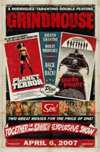
![]()
In 2007 a double feature Grindhouse was presented to the public to decent reviews, but terrible receipts. It’s to date the biggest financial flop of Tarantino’s career. Rodriguez directed Planet Terror and Tarantino took on Death Proof. The two films were shown back to back, but with some guest directors shooting fake movie trailers to show in between. It’s unfortunate that the trailers are the best part though, and it’s a shame that to this day the fake trailers have not been released completely, and that Grindhouse has not been released as a double disc box set. However, the trailers have spawned legitimate films - Machete and it’s sequel Machete Kills, and the Rutger Hauer violent thriller Hobo With a Shotgun. The trailers were hilarious concepts that most of the directors (like Eli Roth) never had a chance to do, but had the money to create something truly bizarre. My favorite was Thanksgiving for it’s absurdity alone.
Planet Terror seems to be the more popular of the two, dealing with zombies and it has Bruce Willis in it. Tarantino makes a cameo as a scummy soldier. Death Proof however, was a slow burner which turned a lot of people off. Tarantino may have gotten a bit too wordy in his dialogue but the overall purpose of Death Proof is to rise to the climax and then hit the audience hard. It’s a common tactic that many filmmakers use, but for Tarantino is didn’t work out as well as he’d hoped.
Kurt Russell plays Stuntman Mike, a retired stuntman who still drives stunt cars that he’s souped up to make them “death proof.” He utilizes this tool to kill 4 women at the beginning of the film using a Chevy Nova and turning his lights off on a dark highway. The scene in which the Nova drives through their car is extremely graphic and hilariously over the top. Unfortunately it comes after a lot of boring dialogue and poor interaction between Kurt Russell and Vanessa Ferlito - whom I will never understand why she was cast. She’s a female Hayden Christiansen in many scenes and is painful to watch.
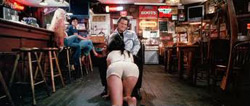 |
| Kurt Russell in Death Proof |
Russell on the other hand is glowing as ever. Crappy movies for decades and now he lands in a Tarantino film, it was likely the best thing to happen to him in years. He’s now back to nothing basically, but he had a brief moment and is really a great talent to the film, despite it’s major pitfalls. His sincerity in the role, coupled with his perverse nature in character, makes him a memorable one no less. His second string of victims, this time lead by Rosario Dawson, leads up to a high speed chase on a Dodge Charger. Zoe Bell, who is an actual stunt woman - she was Uma Thurman’s stunt double in Kill Bill) spends a good amount of time on that Charger’s hood going 70 mph. It’s a breathtaking stunt, but it’s drawn out. The drawn out scene definitely makes it seem more dangerous, but it gets old after awhile.
Even Tarantino has stated that this is worst movie, and it’s because of the rush production and cockiness on his part. The finale to the film is oddly enough the best part as the girls take on Stuntman Mike in a hilarious fatality. It’s hard to justify the film based on that ending though, and in the end the entire Grindhouse experience was entertaining at the very least, but ultimately a misstep.
Inglourious Basterds
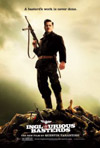
![]()
Thankfully it was followed up by another classic from Tarantino. After a decade in the works, he finally unveiled Inglourious Basterds to the world in 2009. It’s his highest grossing film to date, and was nominated for several Oscars including Best Picture, Director, Original Screenplay, and won for Support Actor Christoph Waltz. A reimagining of World War II if you will, Basterds is not a direct remake of the previous Bastards film. Instead, it just borrows the name (spelled differently) and weaves a tale of the plot to kill Adolf Hitler.
The film opens in 1941 with Hans Landa (Waltz) arriving on a small farm in France and speaking with the owner in regards to him harboring enemies of the state (also known as Jews). After caving and revealing the whereabouts of the Jews hiding in his cellar, LaPadite exits and Landa’s men eradicate them from above. One survivor does manage to escape - Shoshanna, the eldest daughter who runs across the open country and Landa purposely lets her go after briefly contemplating shooting her from a distance. Her entire family murdered, Shoshanna (played by French actress Melanie Laurent) runs for her life and disappears into the country, with revenge in the back of her mind.
Told in an alternate history, one where Hitler is attending the premiere of a Nazi propaganda film “Nation’s Pride” starring Frederick Zoller - a retelling of his actual supposed victory over hundreds of American soldiers. It’s a comical film actually, as a man sits in a tower and just shoots soldiers for what appears to be ages. The mock film is a slap in the face to Nazis and insinuates an obsession with mindless violence.
Basterds was not what everyone thought it would be. Dialogue heavy, much of it in subtitles, and the violence was intermittent. It felt more complete though, then even Kill Bill. It was a hearkening back to his Pulp Fiction days, when he told masterful stories. Filled with unique characters like The Jew Hunter (Christoph Waltz) and The Bear Jew (a buffed Eli Roth), Basterds had the audacity to rewrite history and give America something that it wanted - a justifiable end to Adolf Hitler. Changing history is not something many people would want to see in film, because it doesn’t hold true obviously. Historians can easily say “that didn’t happen.” But for some reason, the absurdity of Basterds is what drew people to it. They knew it wasn’t real, they knew it wasn’t a historical fact, they just wanted to see Hitler get what was coming to him.
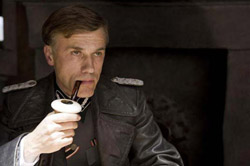 |
| Christoph Waltz in Inglourious Basterds |
It also didn’t hurt that Brad Pitt was in it. Possibly the biggest actor of the last 15 years, Pitt’s name across the marquee definitely helped Basterds get more noticed. As Lt. Aldo Raine (aka The Apache), Pitt leads his Basterds through France and picking up a few scalps along the way. They meet up with Lt. Hicox (Michael Fassbender) and attempt to meet with a German actress top Nazi leaders. The plan goes awry though, and a massacre in the tavern they set to meet up in occurs, leaving Raine to pick up the pieces. Not speaking a lick of German, Raine infiltrates the premiere only to be captured.
As always Pitt delivers, but he’s outmatched by Waltz here as far as acting goes. Hans Landa is truly a despicable villain, one who really gets under your skin. He does it effortlessly. He’s the perfect villain for the film, possibly even worse than Hitler, if he was actually real. Basterds doesn’t pretend to be anything other than a dream come true for the audience. It poses the question “if we could go back in time, would we kill Hitler before the Holocaust?” Tarantino gives that to us, which is why Basterds is a guilty pleasure for audiences. It doesn’t mend any bridges, or bring Nazi war criminals to justice in the real world, but it does give a bittersweet finish to an ugly part of history. This sets Basterds apart from the rest of his films, Tarantino has the audience in his mind when he made Basterds which is why the finale is so rewarding.
His career could be winding down at this point, after having several successful films, a few misfires, and a few extra writing credits. Quentin Tarantino is one of the most recognizable names in film when it comes to directing, and his most recent film opens on Christmas Day - Django Unchained. Unchained keeps the same formula (sort of) as Basterds by telling another history story, but with a very different type of outcome than what we read about and saw in archive footage. I’ve not yet seen the film, but I will be on Christmas Day. Most reviews so far are extremely positive which means Tarantino may have hit another stride. With the director stating that he has no plans to continue making films after he turns 60 that gives us 11 more years of his unique style of filmmaking. Hopefully that’s at least 2 more films, and hopefully he’ll get an Oscar at some point for directing.
With his name slapped as producer on just about everything these days, the high school dropout has lived the American dream like no other. He’s a nerd with a dream, and he’s done it beautifully. Django marks his 7th full feature film, and word around the campfire is that he’ll direct his first true sequel in 2014 with a 10 year reunion with audiences and The Bride. Either way, Bride or no Bride, it’s safe to say that Tarantino rarely disappoints, and even when he does, he backs it up with a stellar follow up.
This concludes our feature on Quentin Tarantino, look for the Django Unchained review on Christmas Day or thereabouts.
Read Part One of Three - Quentin Tarantino - Screenwriting Pioneer
Read Part Two of Three - Quentin Tarantino - 1990s Directing

